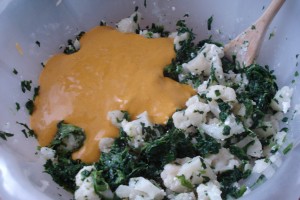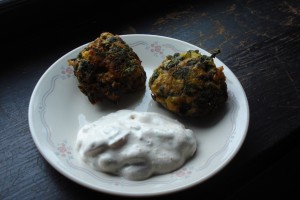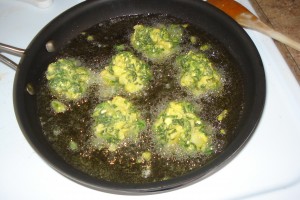 I’ve been meaning to try making a Pakora recipe for quite some time, but seeing that fried appetizers always call for a bit more work than the average recipe (and come with a much smaller margin for error) it took me some time to work up the ambition to give them a try.
I’ve been meaning to try making a Pakora recipe for quite some time, but seeing that fried appetizers always call for a bit more work than the average recipe (and come with a much smaller margin for error) it took me some time to work up the ambition to give them a try.
It was also a matter of occasion and audience. To make a more-ambitious-than-usual recipe happen, I need time to do it with the necessary ingredients on hand. It’s also helpful to have someone to make it for. I can, and do, often enjoy cooking for myself, but that little extra motivation of social cooking is sometimes what I need to talk myself into those more ambitious recipes.
Ordinarily, my parents are a terrible audience for so-called “ethnic” food. They tend to be wary of dishes that stray too far from the ingredients and seasonings they grew up with. Lo and behold, though, my mother’s research into natural health and homeopathic treatments has led to the revelation that *shock* some of these “exotic” spices have unexpected health benefits.  Having discovered that turmeric, and more recently ginger, are potentially beneficial to some of her specific ailments, my mother had taken sometimes to eating these spices dry on her finger, just to get a little in her system, not knowing what else to put it in. This method was ultimately far from pleasant. My challenge then became to show my mother that there are tasty recipes containing at least one, if not both, of these spices, while at the same time not sending her running from the dinner table at the sight and smell of a pungent, spice-rich curry. To keep my parents’ skepticism from rising as they saw and scented peculiar goings-on in the kitchen, I had to assure them that I was using no ingredients beyond what they might consider using in their own cooking… except for the ginger and turmeric, of course. Luckily, my mother had previous experience with besan in her search for flours low on the glycemic index.
Having discovered that turmeric, and more recently ginger, are potentially beneficial to some of her specific ailments, my mother had taken sometimes to eating these spices dry on her finger, just to get a little in her system, not knowing what else to put it in. This method was ultimately far from pleasant. My challenge then became to show my mother that there are tasty recipes containing at least one, if not both, of these spices, while at the same time not sending her running from the dinner table at the sight and smell of a pungent, spice-rich curry. To keep my parents’ skepticism from rising as they saw and scented peculiar goings-on in the kitchen, I had to assure them that I was using no ingredients beyond what they might consider using in their own cooking… except for the ginger and turmeric, of course. Luckily, my mother had previous experience with besan in her search for flours low on the glycemic index.
1 cup besan (i.e. chickpea or gram flour)
1 teaspoon paprika
1 teaspoon turmeric
1 tablespoon ground ginger
2 tablespoons corn starch (optional)
1/2 teaspoon baking soda
salt, to taste
1/2 cup water
PAKORA VEGETABLES
10oz spinach
1 lb. cauliflower, chopped
diced onion
scallions
1/3 to 1/2 cup cottage cheese, optional
oil, for frying
Combine all the dry ingredients for the batter in a medium bowl. Chop the vegetables, if desired. Whisk the water into the dry batter ingredients until smooth. Stir batter into the vegetables until well-coated. Heat oil in a deep fryer or in a skillet. Drop small balls of the vegetable mixture into the hot oil to fry to a golden brown. Serve with raita or chutney.
 The vegetables in this recipe, of course, can be changed. These were simply what I had on hand, but this recipe is open to a lot of variation in content. I don’t have a deep fryer and so I always do a shallow fry (i.e. inch or so of oil) in a non-stick skillet. That method worked out pretty well for these pakora, but the batch turned out very large and I was a little impatient so I make the pakora a bit larger, probably, than they should have been. Next time, I’ll make smaller fritters so they get fried through a little better. I also had to add some extra besan because my vegetables had been frozen and released some liquid while defrosting. If using frozen vegetables, make sure your vegetables are thoroughly thawed and dry, or else extra flour may be in order.
The vegetables in this recipe, of course, can be changed. These were simply what I had on hand, but this recipe is open to a lot of variation in content. I don’t have a deep fryer and so I always do a shallow fry (i.e. inch or so of oil) in a non-stick skillet. That method worked out pretty well for these pakora, but the batch turned out very large and I was a little impatient so I make the pakora a bit larger, probably, than they should have been. Next time, I’ll make smaller fritters so they get fried through a little better. I also had to add some extra besan because my vegetables had been frozen and released some liquid while defrosting. If using frozen vegetables, make sure your vegetables are thoroughly thawed and dry, or else extra flour may be in order.
All in all, though, these fritters were a hit with my parents, and I quite enjoyed them myself. Definitely a recipe I will make again, and hopefully improve upon in the future.

